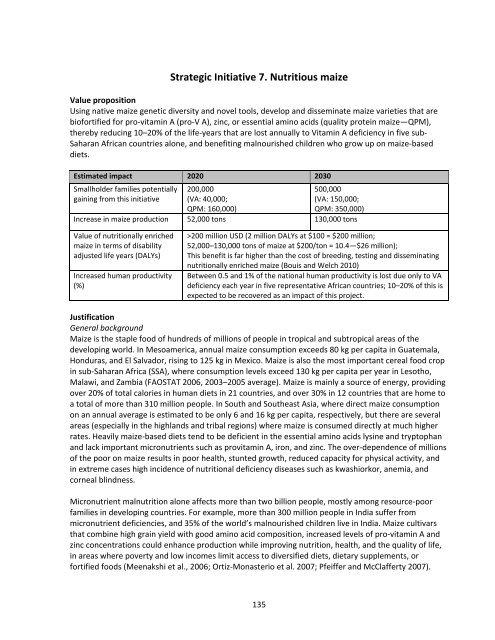Download - Maize
Download - Maize
Download - Maize
You also want an ePaper? Increase the reach of your titles
YUMPU automatically turns print PDFs into web optimized ePapers that Google loves.
Strategic Initiative 7. Nutritious maize<br />
Value proposition<br />
Using native maize genetic diversity and novel tools, develop and disseminate maize varieties that are<br />
biofortified for pro‐vitamin A (pro‐V A), zinc, or essential amino acids (quality protein maize—QPM),<br />
thereby reducing 10–20% of the life‐years that are lost annually to Vitamin A deficiency in five sub‐<br />
Saharan African countries alone, and benefiting malnourished children who grow up on maize‐based<br />
diets.<br />
Estimated impact 2020 2030<br />
Smallholder families potentially<br />
gaining from this initiative<br />
200,000<br />
(VA: 40,000;<br />
QPM: 160,000)<br />
500,000<br />
(VA: 150,000;<br />
QPM: 350,000)<br />
Increase in maize production 52,000 tons 130,000 tons<br />
Value of nutritionally enriched<br />
maize in terms of disability<br />
adjusted life years (DALYs)<br />
Increased human productivity<br />
(%)<br />
>200 million USD (2 million DALYs at $100 = $200 million;<br />
52,000–130,000 tons of maize at $200/ton = 10.4—$26 million);<br />
This benefit is far higher than the cost of breeding, testing and disseminating<br />
nutritionally enriched maize (Bouis and Welch 2010)<br />
Between 0.5 and 1% of the national human productivity is lost due only to VA<br />
deficiency each year in five representative African countries; 10–20% of this is<br />
expected to be recovered as an impact of this project.<br />
Justification<br />
General background<br />
<strong>Maize</strong> is the staple food of hundreds of millions of people in tropical and subtropical areas of the<br />
developing world. In Mesoamerica, annual maize consumption exceeds 80 kg per capita in Guatemala,<br />
Honduras, and El Salvador, rising to 125 kg in Mexico. <strong>Maize</strong> is also the most important cereal food crop<br />
in sub‐Saharan Africa (SSA), where consumption levels exceed 130 kg per capita per year in Lesotho,<br />
Malawi, and Zambia (FAOSTAT 2006, 2003–2005 average). <strong>Maize</strong> is mainly a source of energy, providing<br />
over 20% of total calories in human diets in 21 countries, and over 30% in 12 countries that are home to<br />
a total of more than 310 million people. In South and Southeast Asia, where direct maize consumption<br />
on an annual average is estimated to be only 6 and 16 kg per capita, respectively, but there are several<br />
areas (especially in the highlands and tribal regions) where maize is consumed directly at much higher<br />
rates. Heavily maize‐based diets tend to be deficient in the essential amino acids lysine and tryptophan<br />
and lack important micronutrients such as provitamin A, iron, and zinc. The over‐dependence of millions<br />
of the poor on maize results in poor health, stunted growth, reduced capacity for physical activity, and<br />
in extreme cases high incidence of nutritional deficiency diseases such as kwashiorkor, anemia, and<br />
corneal blindness.<br />
Micronutrient malnutrition alone affects more than two billion people, mostly among resource‐poor<br />
families in developing countries. For example, more than 300 million people in India suffer from<br />
micronutrient deficiencies, and 35% of the world’s malnourished children live in India. <strong>Maize</strong> cultivars<br />
that combine high grain yield with good amino acid composition, increased levels of pro‐vitamin A and<br />
zinc concentrations could enhance production while improving nutrition, health, and the quality of life,<br />
in areas where poverty and low incomes limit access to diversified diets, dietary supplements, or<br />
fortified foods (Meenakshi et al., 2006; Ortiz‐Monasterio et al. 2007; Pfeiffer and McClafferty 2007).<br />
135

















